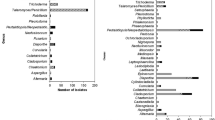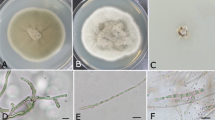Abstract
Fungal endophytes are important yet an underexplored group of microbial organisms that colonize healthy living plant tissues without developing any visible symptoms of disease. These microbes engage in a crucial role in the successful population establishment of alien invasive species in introduced ranges by altering native community structures. Thus, the present work was aimed to isolate and document the endophytic fungi associated with Ageratum conyzoides, an invasive plant species of Tripura, North-east, India, by selecting different vegetative parts viz. leaf, stem and roots, taking into consideration tissue type, sampling sites and season. For the isolation of fungal endophytes, selected explants of vegetative parts of A. conyzoides were inoculated in the MEA (Malt Extract Agar) medium. During this study from eight sampling sites, a total of 480 segments were inoculated, altogether 283 isolates were identified using morphology, microscopic, and molecular characteristics. The maximum number of endophytes were recovered from the stem (101 isolates) and leaf (99 isolates) segments compared to the root (83 isolates) segments. Twenty-two (22) endophytic fungal strains were identified among which nineteen (19) genera belonged to Ascomycota, one (1) in Mucoromycota, and the rest were sterile forms. The sampling site, tissue type, and season-wise diversity of endophytic fungi were analyzed. Pleosporales, Xylariales, and Eurotiales were represented by contributing the most species of endophytic assemblages. Results revealed that fungal endophytes isolated from invasive plant species exhibited tissue and seasonal specificity. This investigation is the first attempt on the study of diversity, tissue-specificity, and seasonal variation of endophytic fungi from invasive alien plant species Ageratum conyzoides of Tripura, Northeastern India (NEI).


Similar content being viewed by others
Code Availability
Not applicable.
Data availability
Not applicable.
References
Aguilar-Trigueros CA, Rillig MC (2016) Effect of different root endophytic fungi on plant community structure in experimental microcosms. Ecol Evol 6(22):8149–8158
Bhattacharya S, Debnath S, Saha AK (2018) Evaluation of antioxidant activity of two endophytic fungi isolated from Ananus comosus L. Eur J Biomed Pharm 5(1):896–899
Boratyn GM, Camacho C, Cooper PS, Coulouris G, Fong A, Ma N, Zaretskaya I (2013) BLAST: a more efficient report with usability improvements. Nucleic Acids Res 41(W1):W29–W33
Casas LL, Pereira JO, Costa-Neto PQ, Silva JF, Almeida LN, Bianco RA, Azevedo JL (2021) Endophytic Colletotrichum siamense for Biocontrol and Resistance Induction in Guarana Seedlings. Int J Microbiol. 1;1925226
Clay K, Shearin ZR, Bourke KA, Bickford WA, Kowalski KP (2016) Diversity of fungal endophytes in non-native Phragmites australis in the Great lakes. Biol Invasions 18:2703–2716
R Core Team (2022) R: A Language and Environment for Statistical Computing. R Foundation for Statistical Computing, Vienna. https://www.R-project.org
Dogra K, Kohli R, Sood SK, Dobhal P (2009) Impact of Ageratum conyzoides L. on the diversity and composition of vegetation in the Shivalik hills of Himachal Pradesh (Northwestern Himalaya), India. Int J Biodivers Conserv 1(4):135–145
Domsch KH, Gams W, Anderson TH (1980) Compendium of soil fungi. Volume 1. Academic Press (London) Ltd
Ellis MB (1971) Dematiaceous hyphomycetes. Commonwealth Mycological Institute, Kew, Surrey, England, p 608
Ganley RJ, Newcombe G (2006) Fungal endophytes in seeds and needles of Pinus monticola. Mycol Res 110(3):318–327
Gouda S, Das G, Sen SK, Shin HS, Patra JK (2016) Endophytes: a treasure house of bioactive compounds of medicinal importance. Front Microbiol 7:1538
Hata K, Futai K (1995) Endophytic fungi associated with healthy pine needles and needles infested by the pine needle gall midge, Thecodiplosis japonensis. Can J Bot 73(3):384–390
Huang WY, Cai YZ, Hyde KD, Corke H, Sun M (2008) Biodiversity of endophytic fungi associated with 29 traditional Chinese medicinal plants. Fungal Divers 33(61):61–75
Jones DT, Taylor WR, Thornton JM (1992) The rapid generation of mutation data matrices from protein sequences. Comput Appl Biosci 8:275–282
Kaur A, Kaur S, Singh HP, Datta A, Chauhan BS, Ullah H, Kohli RK, Batish DR (2023) Ecology, Biology, Environmental impacts, and management of an agro-environmental weed Ageratum conyzoides. Plants 12(12):2329
Kowalski KP, Bacon C, Bickford W, Braun H, Clay K et al (2015) Advancing the science of microbial symbiosis to support invasive species management: a case study on Phragmites in the Great lakes. Front Microbiol 6(95):1–14
Kuklev DV, Domb AJ, Dembitsky VM (2013) Bioactive acetylenic metabolites. Phytomedicine 20:1145–1159. https://doi.org/10.1016/j.phymed.2013.06.009
Kumar S, Stecher G, Li M, Knyaz C, Tamura K (2018) MEGA X: Molecular Evolutionary Genetics Analysis across computing platforms. Mol Biol Evol 35:1547–1549
Matsumura E, Fukuda K (2013) A comparison of fungal endophytic community diversity in tree leaves of rural and urban temperate forests of Kanto district, eastern Japan. Fungal Biology 117(3):191–201
Mei L, Zhu M, Zhang DZ, Wang YZ, Guo J, Zhang HB (2014) Geographical and temporal changes of foliar fungal endophytes associated with the invasive plant Ageratina adenophora. Microb Ecol 67:402–409
Mukhtar I, Khokhar I, Mushtaq S, Ali A (2010) Diversity of epiphytic and endophytic microorganisms in some dominant weeds. Pakistan J Weed Sci Res, 16(3)
Mushtaq W, Shakeel A, Mehdizadeh M, Aghamdi SA, Hakeem KR (2019)– Impact of plant invasions on local vegetation: An Indian perspective. BiosciBiotech Res Asia; 16(4) https://bit.ly/35FnhNw
National Focal Point for APFISN, India (2005) Stocktaking of National Forest Invasive species activities, India (India Country Report 101005). Ministry of Environment and Forests, New Delhi, India
Nei M, Kumar S (2000) Molecular Evolution and Phylogenetics. Oxford University Press, New York
Oita S, Ibáñez A, Lutzoni F et al (2021) Climate and seasonality drive the richness and composition of tropical fungal endophytes at a landscape scale. Commun Biol 4:313. https://doi.org/10.1038/s42003-021-01826-7
Paul S, Datta BK, Ratnaparkhe MB, Dholakia BB (2022) Turning waste into beneficial resource: implication of Ageratum conyzoides L. In sustainable agriculture, environment and biopharma sectors. Mol Biotechnol 64(3):221–244
Photita W, Lumyong S, Lumyong P, Hyde KD (2001) Endophytic fungi of wild banana (Musa acuminata) at doi Suthep Pui National Park, Thailand. Mycol Res 105(12):1508–1513
Qiao Z, Wang Q, Liu J, Wang M (2021) Antioxidant and antibacterial activities of the ethyl acetate extracts of endophytic fungi isolated from Ageratum conyzoides L. J Chin Pharm Sci, 30(5)
Rajini SB, Nandhini M, Udayashankar AC, Niranjana SR, Lund OS, Prakash HS (2020) Diversity, plant growth-promoting traits, and biocontrol potential of fungal endophytes of Sorghum bicolor. Plant Pathol 69(4):642–654
Rho H, Hsieh M, Kandel SL, Cantillo J, Doty SL, Kim SH (2018) Do endophytes promote growth of host plants under stress? A meta-analysis on plant stress mitigation by endophytes. MicrobEcol 75(2):407–418
Sambrook J, Fritsch EF, Maniatis T (1989) Molecular cloning: a laboratory manual. No. Ed. 2. Cold spring harbor laboratory press
Schulz B, Wanke U, Draeger S, Aust HJ (1993) Endophytes from herbaceous plants and shrubs: effectiveness of surface sterilization methods. Mycol Res 97(12):1447–1450
Watanabe T (2002) Pictorial atlas of soil and seed fungi: morphologies of cultured fungi and key to species. CRC
Funding
Not applicable.
Author information
Authors and Affiliations
Contributions
P.D. and A.K.S. conceived the idea and designed the experiments. P.D. conducted the experiments and collected the data. P.D. prepared the initial draft. P.D., S.T., R.S., and S.P. analyzed the data and edited the draft. P. Das edited the manuscript and finalized the draft. A.K.S. supervised the study and also edited the draft. Subsequently, all authors have approved the final version of the manuscript.
Corresponding author
Ethics declarations
Ethical approval
Not applicable.
Consent for publication
Not applicable.
Consent to participate
Not applicable.
Conflict of interest
Authors declared there is no conflict of interest.
Additional information
Publisher’s Note
Springer Nature remains neutral with regard to jurisdictional claims in published maps and institutional affiliations.
Electronic supplementary material
Below is the link to the electronic supplementary material.
Rights and permissions
Springer Nature or its licensor (e.g. a society or other partner) holds exclusive rights to this article under a publishing agreement with the author(s) or other rightsholder(s); author self-archiving of the accepted manuscript version of this article is solely governed by the terms of such publishing agreement and applicable law.
About this article
Cite this article
Debbarma, P., Tripura, S., Saha, R. et al. Diversity and seasonal variation of fungal endophytes associated with Ageratum conyzoides L.: an invasive species. Vegetos (2024). https://doi.org/10.1007/s42535-024-00921-4
Received:
Revised:
Accepted:
Published:
DOI: https://doi.org/10.1007/s42535-024-00921-4




